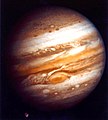Fitxategi:Jupiter gany.jpg

Aurreikuspen honen neurria: 538 × 600 pixel. Bestelako bereizmenak: 215 × 240 pixel | 431 × 480 pixel | 673 × 750 pixel.
Bereizmen handikoa ((673 × 750 pixel, fitxategiaren tamaina: 114 KB, MIME mota: image/jpeg))
Fitxategiaren historia
Data/orduan klik egin fitxategiak orduan zuen itxura ikusteko.
| Data/Ordua | Iruditxoa | Neurriak | Erabiltzailea | Iruzkina | |
|---|---|---|---|---|---|
| oraingoa | 12:17, 15 urria 2023 |  | 673 × 750 (114 KB) | 0x0a | offcial JPG, more details |
| 10:19, 16 otsaila 2016 |  | 970 × 1.081 (281 KB) | PlanetUser | black bg | |
| 06:20, 15 martxoa 2015 |  | 970 × 1.081 (72 KB) | Jcpag2012 | larger (with auto correction) from TIFF file | |
| 07:24, 22 otsaila 2015 |  | 758 × 858 (238 KB) | Jcpag2012 | processing | |
| 06:14, 9 azaroa 2004 |  | 758 × 858 (58 KB) | Gentgeen | {{PD-USGov-NASA}} |
Irudira dakarten loturak
Hurrengo orrialdeek dute fitxategi honetarako lotura:
Fitxategiaren erabilera orokorra
Hurrengo beste wikiek fitxategi hau darabilte:
- af.wikipedia.org proiektuan duen erabilera
- ar.wikipedia.org proiektuan duen erabilera
- be.wikipedia.org proiektuan duen erabilera
- bg.wikipedia.org proiektuan duen erabilera
- cs.wikipedia.org proiektuan duen erabilera
- en.wikipedia.org proiektuan duen erabilera
- en.wiktionary.org proiektuan duen erabilera
- es.wikipedia.org proiektuan duen erabilera
- et.wikipedia.org proiektuan duen erabilera
- fr.wikipedia.org proiektuan duen erabilera
- gu.wikipedia.org proiektuan duen erabilera
- he.wikipedia.org proiektuan duen erabilera
- hi.wikipedia.org proiektuan duen erabilera
- hr.wikipedia.org proiektuan duen erabilera
- hr.wiktionary.org proiektuan duen erabilera
- hy.wikipedia.org proiektuan duen erabilera
- id.wikipedia.org proiektuan duen erabilera
- it.wikipedia.org proiektuan duen erabilera
- it.wiktionary.org proiektuan duen erabilera
- ja.wikipedia.org proiektuan duen erabilera
- ja.wiktionary.org proiektuan duen erabilera
- kbp.wikipedia.org proiektuan duen erabilera
- la.wikipedia.org proiektuan duen erabilera
- mdf.wikipedia.org proiektuan duen erabilera
- mk.wikipedia.org proiektuan duen erabilera
- ml.wikipedia.org proiektuan duen erabilera
- mr.wikipedia.org proiektuan duen erabilera
- mwl.wikipedia.org proiektuan duen erabilera
- nl.wikipedia.org proiektuan duen erabilera
- no.wikipedia.org proiektuan duen erabilera
- pl.wikiquote.org proiektuan duen erabilera
- ps.wikipedia.org proiektuan duen erabilera
- pt.wikipedia.org proiektuan duen erabilera
Ikus fitxategi honen erabilpen global gehiago.



